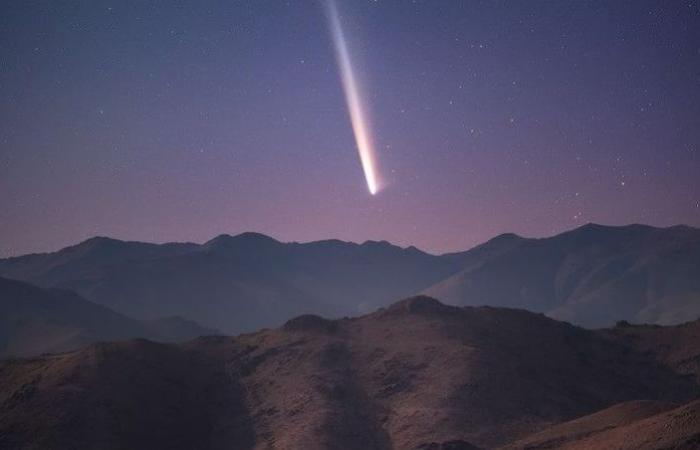
A traveler with hair and no visa who comes from very far away to – we hope – dazzle us. Comet Tsuchinshan-Atlas, codenamed “C/2023 A3”, is due to land in our night sky this Friday, October 11. The diameter of its core is estimated between 20 and 40 kilometers, compared to 11 km for the famous Halley’s comet, which boomers remember. Where does this big ball of ice cream come from? Why does it arouse so much enthusiasm among astronomers? And, above all, how can we see the tail? 20 Minutes tells you everything.
Why is it a candidate for the title of “comet of the century”?
This comet is not one of those whose passage astronomers, clinging to their telescopes, have been waiting for decades. For the good and simple reason that its last passage dates back approximately 80,000 years and they did not even know of its existence. It was observed for the first time in January 2023 as it crossed the orbit of Saturn, by the Chinese observatory of Tsuchinshan, “purple mountain” in Mandarin. Then a few months later by the South African Atlas program. Hence its partly unpronounceable baptismal name.
“It comes from very far away in our solar system, from a very cold region called the Oort system,” explains Nicolas André (CNRS-Irap), professor of planetary science at Isae-SUPAERO in Toulouse. It passed behind the Sun on September 27. Initial observations indicate that she survived this fiery stage. There, it moves away from the sun again and comes back towards us. It will come as close as possible to Earth, 70 million kilometers away, on Saturday October 12.
“If it is bright enough, and if the weather permits, in the coming days it will be a spectacle that we could see with the naked eye,” specifies the researcher. Now, comets that can be seen with the naked eye like that, there are one or two per century. The last one was the Hale-Bopp comet, in 1997.” Furthermore, by playing Icarus near the Sun, “C/2023 A3” came out warmed by its contact. It is ready to “degas” a beautiful plume and eject piles of molecules ionized by solar rays, in a “fascinating” spectacle of a “hair of gas and dust which could change every day”.
How to see it?
So how can you enjoy the show if it’s there? “It will be enough,” advises Nicolas André, “to wait [prudemment] as the Sun sets on the western horizon. And if it is clear, we will first see it low on the horizon, then as the days go by it rises a little in the sky. “, Obviously, as it moves away from the Sun, it will become less and less luminous. “So it’s really in the next few days that we have to observe it,” insists the specialist. It will then be “visible for a good week, with small binoculars and small telescopes”. Later, only the most sophisticated instruments will still be able to follow his trail.
What can it teach us?
The Toulouse researcher predicts an “intense observation campaign”, absolutely “exciting”. Because this “ball of ice” theoretically contains invaluable material. “It is a good messenger who will allow us to know what we are made of, to observe what we call primordial matter,” he notes. “We will be able to probe with telescopes the composition of the matter escaping from the cometary nucleus, analyze the composition of the molecules in the plume, and thus go back to the composition of the nucleus and the basic building blocks which created the objects of the solar system “.
A promising aperitif for the community of astronomers before the launch, planned for 2029, of the European Comet Interceptor mission. Its three ships will wait, in “parking orbit” around the Earth, for the signal from the most powerful ground telescopes of another comet of the Tsuchinshan-Atlas type. The idea is to intercept its orbit to observe primordial matter even more closely.





